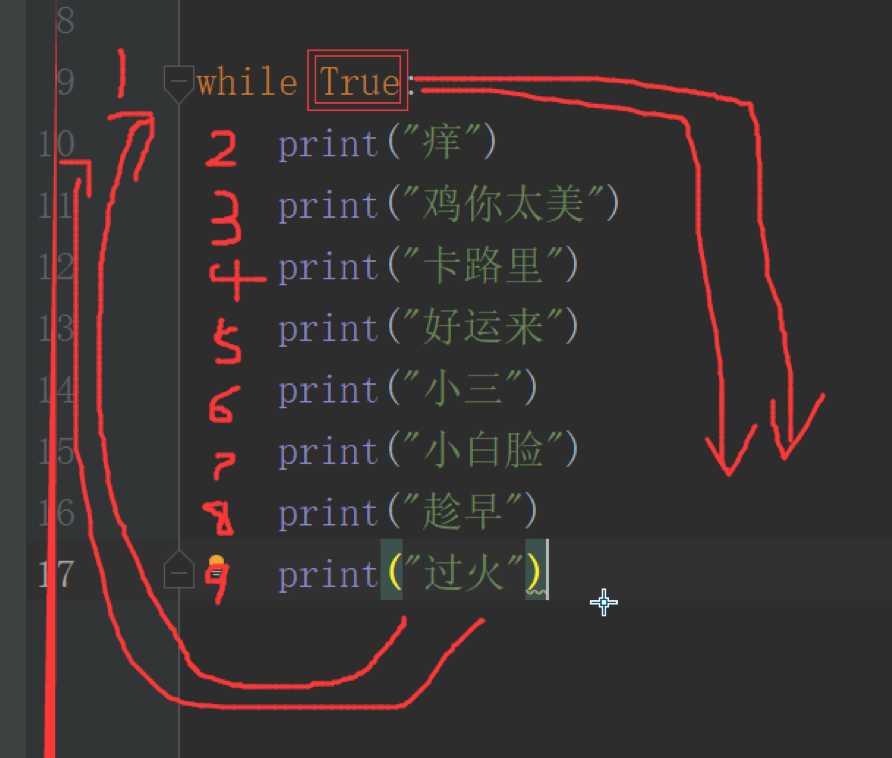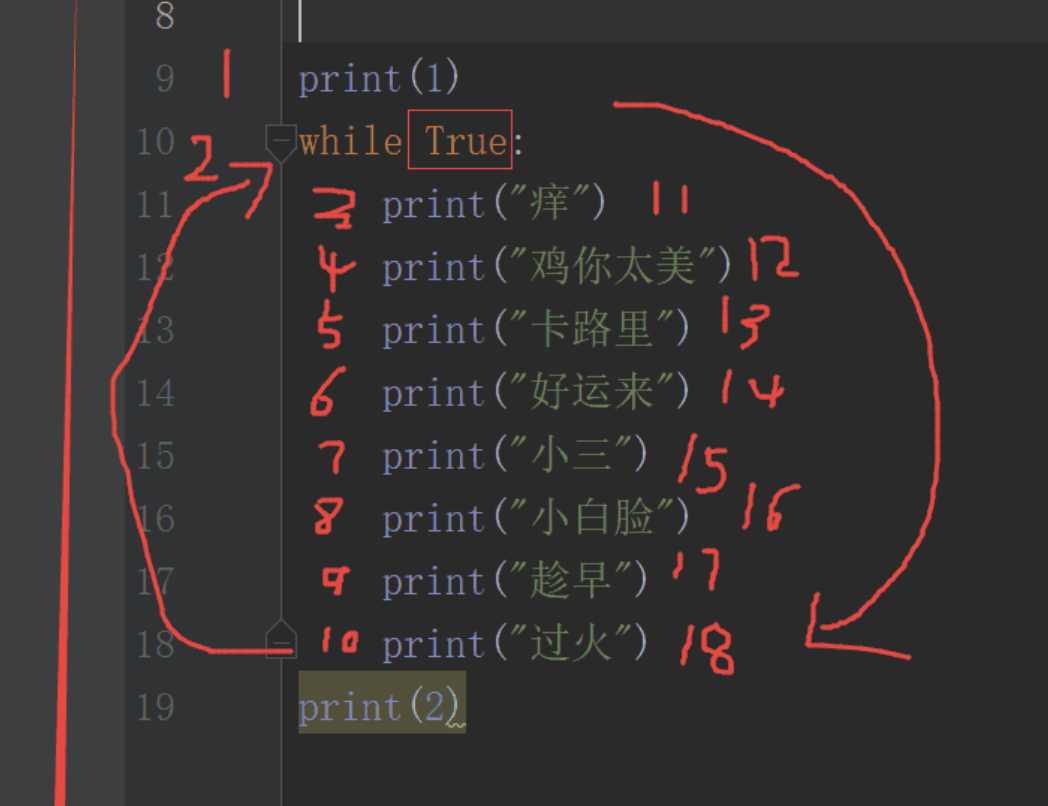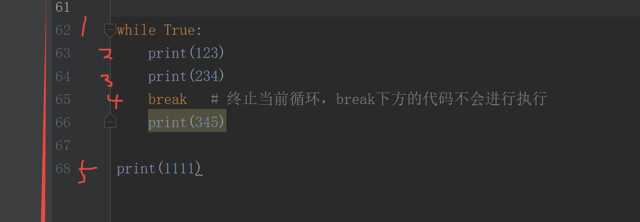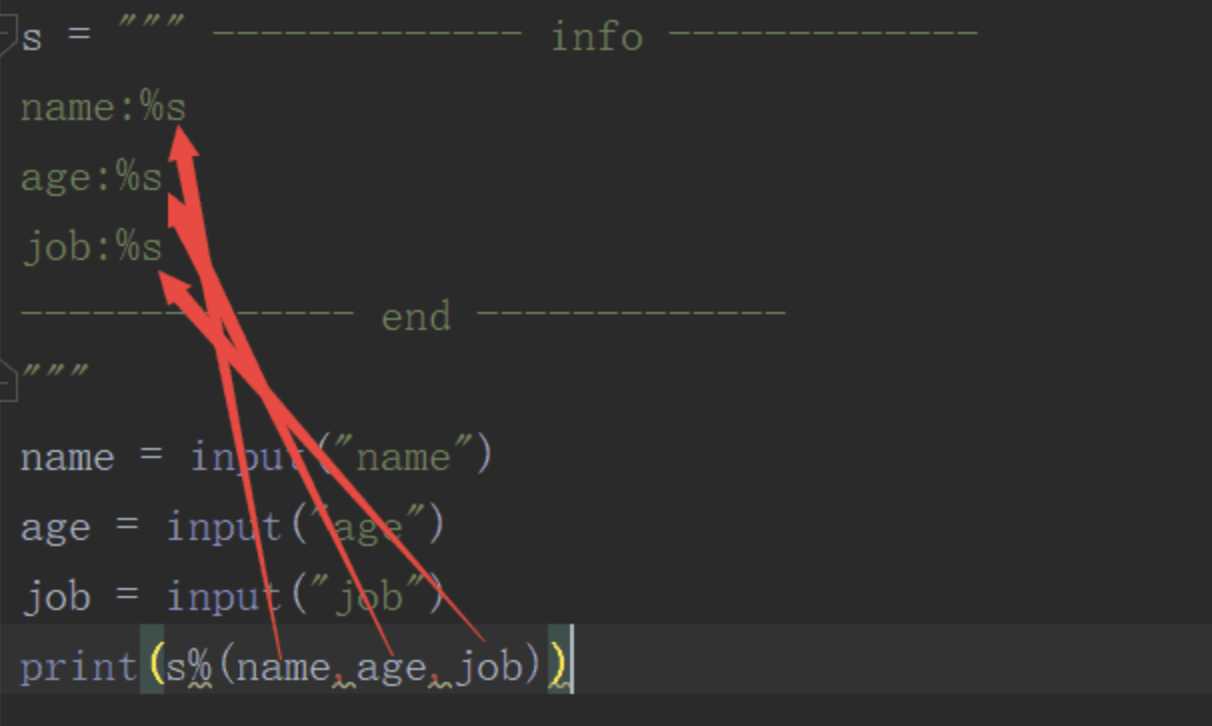python 第二章,,第二章while 循
python 第二章,,第二章while 循
第二章
while 循环
# while -- 关键字(死循环)# while 条件 冒号# 缩进 循环体# 停止while要点击红色停止,不能只关闭窗口while True: print("痒") print("鸡你太美") print("卡路里") print("好运来")
while False: print("痒") print("鸡你太美") print("卡路里") print("好运来")# 无输出print(1)while True: print("痒") print("鸡你太美") print("卡路里") print("好运来")print(2)# 循环输出,print(2)不输出
print(1)while False: print("痒") print("鸡你太美") print("卡路里") print("好运来")print(2)# 输出12falg = Truewhile falg: print(1)print(2)# 循环输出1# 通过数字转成布尔值print(bool(1))# 数字里面非0的都是Truecount = 1while count: print(count) count = count + 1# 循环输出,每次+1# 正序count = 1while count <= 5: print(count) count = count + 1# 输出12345
# 倒序count = 5while count: print(count) count = count - 1# 输出54321# 正序打印从 25-57count = 25while count <= 57: print(count) count = count + 1# 倒序打印从 57-25count = 57while count >= 25: print(count) count = count - 1
# break 终止当前循环,break下方的代码不会进行执行while True: print(123) print(234) break print(345)print(111)# 输出123234111

# continue 临时当作循环体中的最后一段代码# 跳出当前循环,继续下次循环# 下面的代码不会再执行while True: print(123) print(234) continue # 伪装成最后一段代码 print(345)print(111)# 循环输出123234# else 的用法# 条件不成立跳出当前while循环# 当为真的时候while True: print(111)else: print(222)# 循环输出111while True: print(111)print(222)# 循环输出111#当为假的时候while False: print(111)else: print(222)# 输出222while False: print(111)print(222)# 输出222#为真且有breakwhile True: print(111) breakelse: print(222)# 循环输出111while True: print(111) breakprint(222)# 循环输出111222#为假且有breakwhile False: print(111) breakelse: print(222)# 循环输出222while False: print(111) breakprint(222)# 循环输出222
# 总结:# 打断循环的方式:# 1.通过自己修改条件# 2.break# break -- 打破当前循环(终止当前循环)# continue -- 跳出当前循环,继续下次循环(伪装成最后一段代码continue 什么时候用?)# break和continue相同之处:以下代码均不执行
字符串的格式化
a = "---info---"b = "name"c = "age"d = "job"e = "---end---"print(a+b+c+d+e)# 输出# ---info---nameagejob---end---a = "---info---"b = "name"c = "age"d = "job"e = "---end---"print(a+"\n"+b+"\n"+c+"\n"+d+"\n"+e)# 输出# ---info---# name# age# job# ---end---name = input('请输入姓名:')age = input('请输入年龄:')job = input('请输入职业:')a = "---info---"b = "name:"c = "age:"d = "job:"e = "---end---"print(a+'\n'+b+name+'\n'+c+age+'\n'+d+job+'\n'+e)# 输出# 请输入姓名:张三# 请输入年龄:25# 请输入职业:python# ---info---# name:张三# age:25# job:python# ---end---# %s 占位符 类型为s 是占的字符串类型的位置# %d 占位符 类型为数字 是占的数字类型的位置# s% 按照位置顺序传递,占位和补位一一对应s = """---info---name:%s age:%djob:%s---end---"""name = input("请输入姓名:")age = int(input("请输入年龄:"))job = input("请输入职业:")print(s%(name,age,job))# 输出# 请输入姓名:张三# 请输入年龄:25# 请输入职业:python# ---info---# name:张三# age:25# job:python# ---end---#多、少位置均不行s = """--info--name:%s age:%djob:%s---end---"""name = input("name")age = int(input("age"))job = input("job")print(s%(name,job,))# 少位置报错:TypeError: %d format: a number is required, not str
# %% 两个百分号为转义num = input("学习进度:")B = "学习进度为:%s %%"print(B%(num))# 输出学习进度为:30 %
sll = "学习进度为:%s"print(sll%("不错"))# 输出学习进度为:不错# f也可以做格式化s = f"{1}{2}{3}"print(s)# 输出123s = f"今天下雨了{input('>>>')}"print(s)# 输出 今天下雨了+输入的内容运算符
# 算术运算符# + - * /# // (整除--地板除)# python2跟python3的除有区别# ptyhon2 获取到的是整数# python3 获取到的是小数 浮点型print(5//2)# 输出2# ** 幂 (次方)print(3**2)# 输出9# % 模 (取余)print(5%2)# 输出1# 比较运算符# ># <# ==(等于)# !=(不等于)# >=# <=# 赋值运算符# = 赋值# += 自加a = 10a += 1print(a)# 输出11# -= 自减# *= 自乘a = 10a *= 2print(a)# 输出20# /= 除法赋值# //= 取整赋值# **= 幂赋值# %= 取模赋值# 逻辑运算符# and (与/和)# and 都为真,取and后面的值print(3 and 4)# 输出 4# and 都为假。取and前面的值print(0 and False)# and 一真一假取假的,假的取前面的值print(0 and 4)# 输出0print(3 and 5 and 9 and 0 and False)# 输出0print(5 and False and 9 and 0)# 输出Falseprint(1 and 2 and 5 and 9 and 6)# 输出6# or (或)# or 都为真,取or前面的值print(1 or 2)# 输出1# or 都为假。取or后面的值print(False or 0)# 输出0# or 一真一假取真的print(0 or 1)# 输出1print(1 or 9 or 4 or 0 or 9)# 输出1print(1 or 2 or 4 or 8 or 6)# 输出1print(0 or False)# 输出False# not (非)print(not False)# 输出True# 优先级# ()> not > and > or# and 从左向右执行print(9 and 1 or not False and 8 or 0 and 7 and False)# 输出1print(9 and 1 or True and 8 or 0 and 7 and False) # not False = Trueprint(1 or True and 8 or 0 and 7 and False)# 9 and 1 取1print(1 or 8 or 0 and 7 and False)# True and 8 取8print(1 or 8 or 0 and False)# 7 and False 取Falseprint(1 or 8 or 0)# 0 and False 取0# 1 or 8 or 0 取1# 成员运算符# in 存在# not in 不存在s = "abc"if "ab" in s: print(True)else: print(False)# 输出Trues = "abc"if "ab" not in s: print(True)else: print(False)# 输出False
编码初识
# ascii (美国) 不支持中文# gbk (国标) 英文8位,中文16位# unicode(万国码) 英文16位 中文32位# utf-8 (可变长编码) 英文8位 欧洲文16位 亚洲24位# linux -- utf -8# mac -- utf -8# windows -- gbk# 单位转换:# 1字节 = 8 位# 1Bytes = 8bit# 1024Bytes = 1KB# 1024KB = 1MB# 1024MB = 1GB# 1024GB = 1TB# 1024TB = 1PB# 1024PB = 1EB# 1024EB = 1ZB# 1024ZB = 1YB# 1024YB = 1NB# 1024NB = 1DB
今日总结
# 1、while循环 死循环:# while 条件 冒号# 缩进 循环体## 打断死循环:# break:终止当前循环# 改变条件:自动自定义修改控制执行次数## 关键字:# break:终止当前循环# continue:伪装成循环体中最后一行代码(跳出本次循环,继续下次循环)# while else:while 条件成立,后面代码不执行;条件不成立,继续执行else## while else# while 条件成立的时候不执行# 条件成立执行else## 2、字符串格式化:# % 占位# %s 占字符串类型的位# %d 占数字类型的位# %% 转义成普通的百分号# 变量名%() 起到连接的作用# s = "您好%s"# s%("我好")# print(s%("我好"))# f"{变量名}{字符串}{}"3.6以及以上才能使用## 3、运算符:# 算数运算符: + - * / // ** %# 比较运算符: > < >= <= == !=# 赋值运算符: = += -= *= /= //= **= %=# 逻辑运算符: and or not () > 优先级:not > and > or# 成员运算符: in not in## 4、编码:# 编码集(密码本)# ascii:不支持中文# gbk:# 英文 8位 1字节# 中文 16位 2字节# unicode:# 英文 16位 2字节# 中文 32位 4字节# utf-8:# 英文 8位 1字节# 欧洲 16位 2字节# 亚洲 24位 3字节# # 单位转换:# # 1字节 = 8位# # 1Bytes = 8bit ***# # 1024Bytes = 1KB# # 1024KB = 1MB# # 1024MB = 1GB# # 1024GB = 1TBpython 第二章
评论关闭